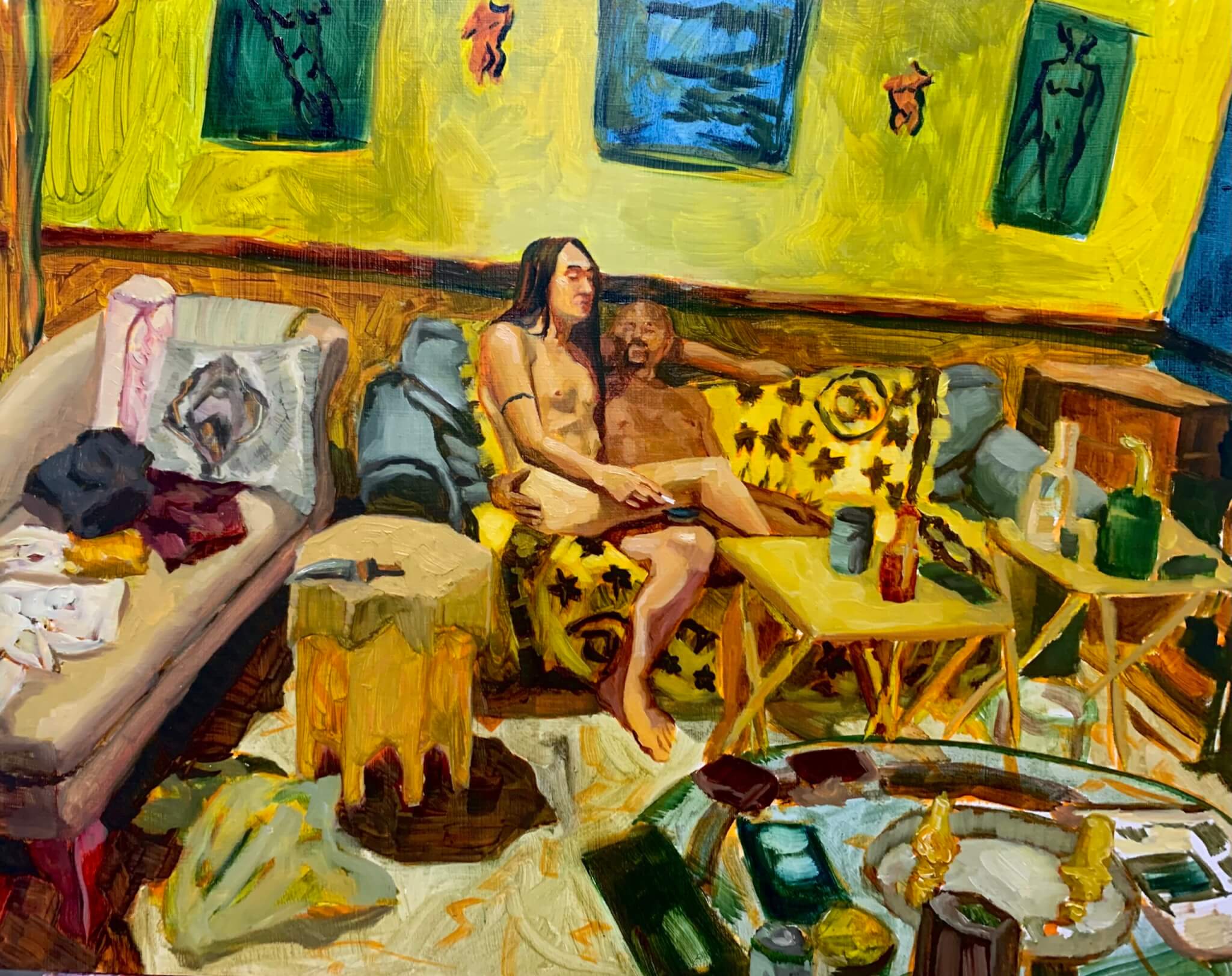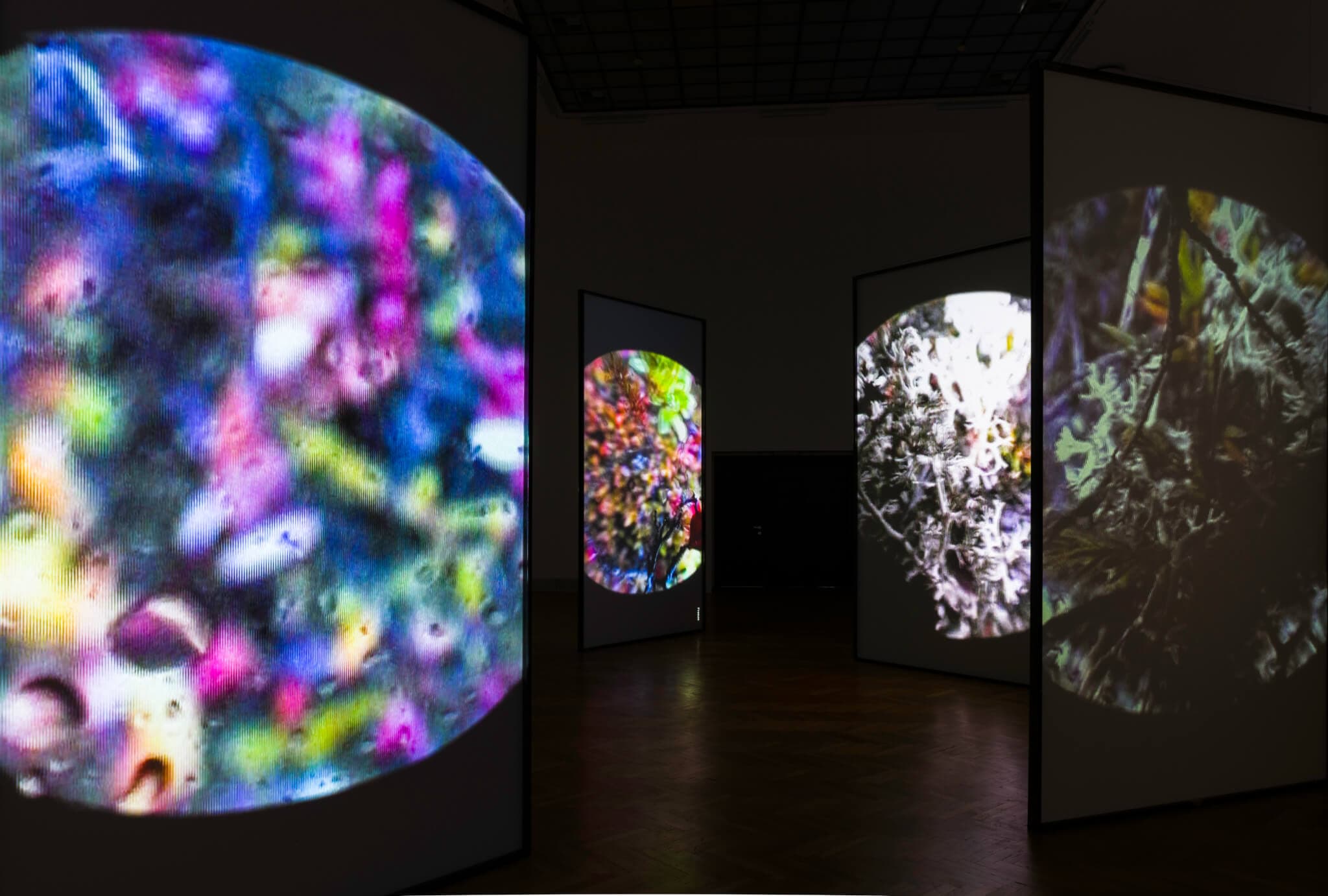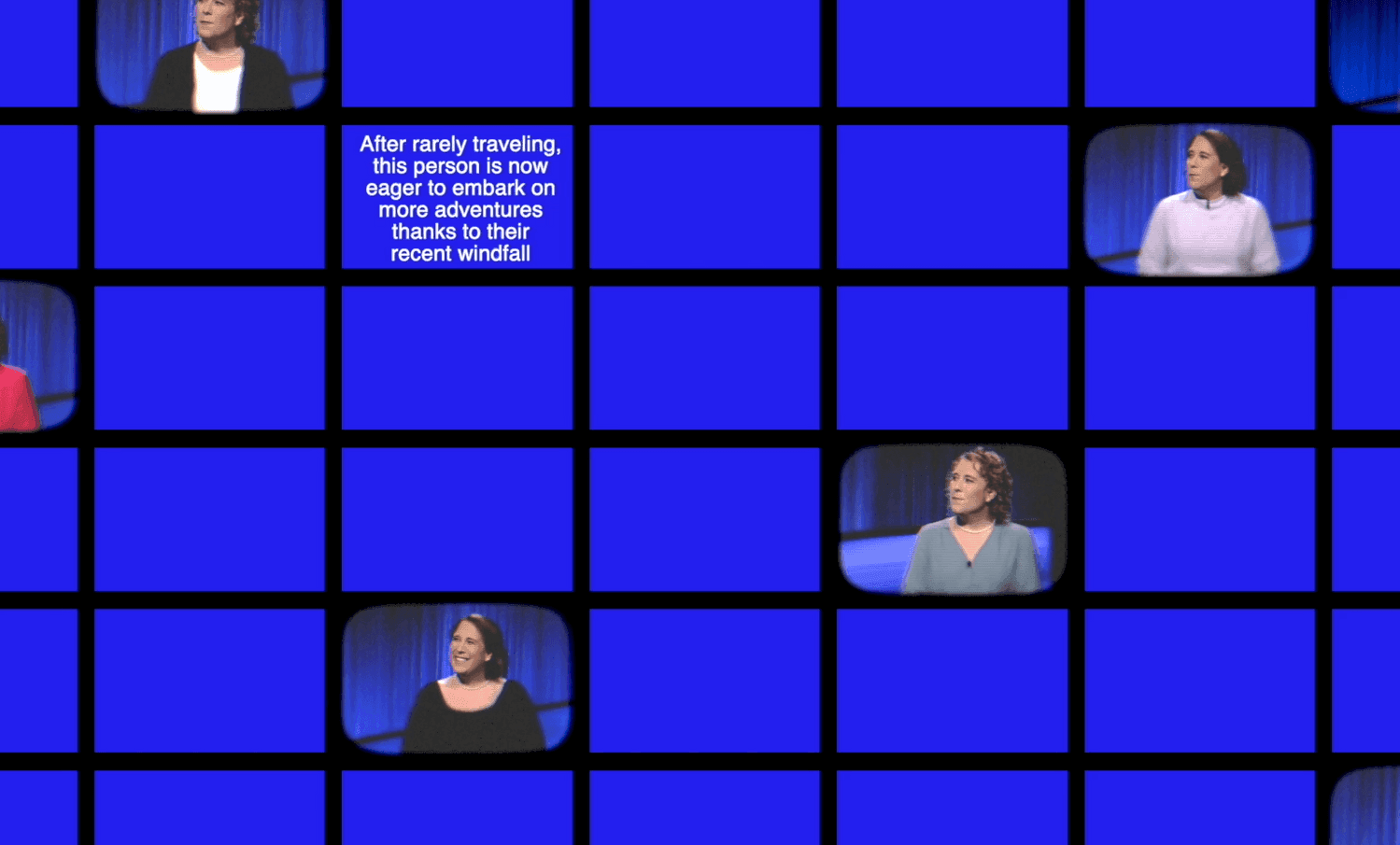This fall, our editors have compiled a list of exhibitions that reimagine our relationships to the places we often return to—home, work, the classroom, and, for art lovers, museums and gallery spaces. We’re looking forward to major career retrospectives, including Charles Atlas’s expansive survey at the ICA, as well as breakout solo shows like J Rowen O’Dwyer’s at the BCA. Hotly anticipated exhibitions include Jeffrey Gibson’s takeover of Building 5 at MASS MoCA and Hugh Hayden at the Rose Art Museum. Meanwhile, experimental projects like Amani Willett’s evocative photo series at Abakus Projects and Elizabeth Withstandley’s installation at Brookline Arts Center provide opportunities for challenging ideas around truth and fiction.

J Rowen O’Dwyer, Remy’s at 3am, 2023. Oil on panel. Courtesy of the BCA.
“J Rowen O’Dwyer: DEVOTIONS, to a dirty queer home,” August 31–December 7, 2024
BCA Mills Gallery
551 Tremont St., Boston, MA
O’Dwyer’s solo exhibition is a colorful window into the artist’s community of friends, lovers, trans folks, and leather dykes. Featuring figure paintings, objects, and zines, the show celebrates queer love and intimacy, the beautiful complexity of bodies, and “the healing and vulnerable act of seeing and being seen.” It showcases O’Dwyer’s talents not only as a painter but as a community organizer through Dirty Queer Living, a collaborative zine project exploring trans and leatherdyke experiences across time and space, lovingly dedicated to the late Boston artist/educator Danielle Abrams. Through tender portraits and everyday scenes of peace and pleasure, O’Dwyer’s exhibition shows how a “dirty queer home” can be found in many people and places.
—Gina Lindner

Andrew Mowbray’s wind-drawing machine. Photo by Sam Toabe.
“Nurture: Empathy for the Earth,” September 3–December 14, 2024
University Hall Gallery, UMass Boston
100 Morrissey Blvd., Boston, MA
On October 25 and 26, UMass Boston will host Thinking About Climate Change: Art, Science and Imagination in the 21st Century, an interdisciplinary symposium with artists, scientists, and policymakers to discuss actionable solutions to climate change that are focused both on hyperlocal locations and global impact. In the University Hall Gallery located in the heart of the Campus Center, an accompanying exhibition features the work of artists who are addressing humanity’s destructive impact on the planet head on. Erin Genia has created a site-specific installation for her light sculpture Eclipse (2017), which is meant to invoke the humbling and collective experience of witnessing cosmic events. On the Harborwalk just outside the gallery, Andrew Mowbray’s mesmerizing wind drawing machine (on view through September 27) is something between sculpture and pseudo science. Meanwhile, Nancy Valladares has collected spent fixative from the UMass Boston darkroom to extract silver nitrate—a material that major corporations like Kodak extracted from the earth, causing major ecological disasters. Other artists include Resa Blatman, Amy Kaczur, Michelle Lougee, Sheida Soleimani, Bethany Taylor, and Christopher Volpe.
—Jameson Johnson

Chukwudumebi Gabriel Amadi-Emina, Fade Catcher, 2021. Matte inkjet prints mounted on dibond. Courtesy of the artist.
“States of Becoming,” September 9–December 8, 2024
McMullen Museum of Art, Boston College
2101 Commonwealth Ave., Boston, MA
Fitsum Shebeshe’s experience defining and redefining his identity led him to curate “States of Becoming,” a traveling exhibition of contemporary artists of the African Diaspora. Curator and artist Shebeshe emigrated from Addis Ababa, Ethiopia, to Baltimore, Maryland, in 2016 and found communion with a countrywide group of diasporic artists exploring lineage, cultural hybridity, transformation, and belonging in their work. Produced by Independent Curators International and co-organized by Boston College’s African and African Diaspora Studies Program for its New England debut, the exhibition includes twenty-eight works by seventeen artists connected to twelve countries in Africa, and one in the Caribbean, who are currently living across the US. Providence- and New York–based Helina Metaferia uses performance and photography to insert her body and spectatorship in, or against, a Western art historical canon. New Haven–based Nontsikelelo Mutiti recreates braiding salons from Zimbabwe to Harlem with mixed media. Spanning video, photography, painting, installation, sculpture, and graphic design, these artists ask a central question, where “States” reflects both a physical and psychological place that is unstable, and therefore malleable: How do we become, and become again, who we are?
—Niara Simone Hightower

Attributed to Jules Courtier, Eusapia Palladino levitating a table during a séance “without threads,” about 1907–9. Retouched photograph. Collection of Tony Oursler. Photo courtesy of Oursler Studio.
“Conjuring the Spirit World: Art, Magic, and Mediums,” September 14, 2024–February 2, 2025
Peabody Essex Museum
161 Essex St., Salem, MA
When considering occult traditions in New England (Salem particularly), witchcraft and its horrific attendant trials initially come to mind, though the region has a long history of dabbling in esoteric practices, many of which received at least a marginally warmer welcome, some of which were embraced by the highest echelons of society. At the Peabody Essex Museum, the new exhibition “Conjuring the Spirit World: Art, Magic, and Mediums” presents objects from the latter category. Popularized in the nineteenth century, Spiritualism captivated the area’s middle and upper classes, with parlor magic and seances captivating crowds of hopefuls searching for the supernatural. In this show, PEM curator-at-large George H. Schwartz gathered artifacts and ephemera from across the country that were used to flabbergast the senses and facilitate connections and communication with the dead. From the knuckle-cracking (ghost rapping) Fox sisters to ectoplasm to contemporary works by Tony Oursler, José Alvarez (D.O.P.A.), and Shannon Taggart, this show is the perfect way to usher in the spooky season.
—Jessica Shearer

Hugh Hayden, Hedges, 2019. Sculpted wood, lumber, hardware, mirror, and carpet. 144 x 208 x 208 in. (365.8 x 528.3 x 528.3 cm). © Hugh Hayden; Courtesy The Shed Open Call and Lisson Gallery. Photo courtesy of Mark Waldhauser.
“Hugh Hayden: Home Work,” September 18, 2024–June 1, 2025
Rose Art Museum, Brandeis University
415 South St., Waltham, MA
You may have seen one of Hugh Hayden’s wooden wonders at the deCordova in Lincoln, where his Huff and Puff offers a new angle on Thoreau’s famed Walden digs, or at the Lot Lab at the Charlestown Navy Yard, where Gulf Stream gives a rowboat a ribcage. Now the Texas-born, New York–based artist known for uncanny evocations of history and African American identity is receiving his first New England solo exhibition, one that surveys a decade of work and delves deep into the country’s collective unconscious. Drawing on regional craft traditions, Hayden transforms familiar domestic furnishings into unsettling sculptures, covering a cradle in thorns, entangling school desks in brambles, and turning an armoire into a cotton-picking claw machine. The comforts of home are anything but comfortable in this psychologically charged show, a chance to catch up with a dynamic sculptor dredging the dangers lurking beneath the American Dream.
—Jacqueline Houton

Mickalene Thomas, Sandra, She’s a Beauty, 2009. Artist rendering (detail) © Mickalene Thomas.
“Mickalene Thomas: Sandra, She’s a Beauty, 2009,” October 1, 2024–February 17, 2025
Isabella Stewart Gardner Museum
25 Evans Way, Boston, MA
With colossal gold cuff bracelets from wrist to elbow, bright red fishnet stockings and a red lipgloss to match, big curly hair, and bone structure that is simply unmatched, Sandra Bush is a beauty and she knows it! Beginning this fall, Mickalene Thomas’s Sandra, She’s a Beauty (2009)—a photo collage of the artist’s mother and early muse—will grace the Anne H. Fitzpatrick façade at the Gardner Museum. Reminiscent of the Gardner’s Édouard Manet portrait of his own mother, Thomas’s piece refers to the Western canon of portraiture while challenging it significantly. She floods the frame with color and reverence. Perfectly poised on a couch of colorful mixed fabrics, Sandra smiles brightly in a symmetrical red and black ensemble. Thomas plays up the bold furniture patterns using collage to frame her beloved sitter. Visitors to the museum will be ushered in beneath Sandra’s radiance.
—Alisa V. Prince

Amani Willett, Hiding Place, Cambridge, MA., 2010. Image courtesy of the artist and Abakus Projects.
“Amani Willett: Hiding in Place,” October 4–November 24, 2024
Abakus Projects
450 Harrison Ave., #309A, Boston, MA
In an essay titled “The Site of Memory,” Toni Morrison wrote: “Therefore the crucial distinction for me is not the difference between fact and fiction, but the distinction between fact and truth. Because facts can exist without human intelligence, but truth cannot.” Amani Willett takes up just that in a photographic series that interrogates the history, memory, and mythology of the Underground Railroad. Willett is the son of a Black mother and a white father who were both raised as Quakers in a tradition with deep ties to the abolitionist movement. The project has its origins in the artist’s personal exploration and evolved as he embraced the human tendency to mold stories that fit our needs. Willett’s gorgeously lit photographs span interior and exterior sites that hold onto the facts we choose to remember and the truths we choose to project.
—Alisa V. Prince

Charles Atlas, MC⁹, 2012. Installation view: Merce Cunningham, Clouds and Screens, Los Angeles County Museum of Art, 2018. Photo © Museum Associates/LACMA. Courtesy Los Angeles County Museum of Art.
“Charles Atlas: About Time,” October 10, 2024–March 16, 2025
Institute of Contemporary Art / Boston
25 Harbor Shore Dr., Boston, MA
In the 1970s, Charles Atlas was a budding filmmaker who had no intention of building a career making dance films. By chance, he took a job at Merce Cunningham Dance Company, where, over the course of a ten-year residency, he pioneered the “media-dance” genre—dance choreographed for film as opposed to for a live audience. “Charles Atlas: About Time” is a first-of-its-kind retrospective spanning the artist’s fifty-year career. Atlas has transformed his films and single-channel videos, which often touch on themes of queer and gay sexuality, into multi-channel installations composed of towering screens that visitors may walk around and between. The fun is in realizing that the disparate moving images—an errant hand, a flexed foot—are extensions of the same body in motion. And more, that by weaving in and around Atlas’s carefully curated video structures, you, too, are a part of the groundbreaking artist’s latest experiment.
—Ava Mancing

Steina, Borealis, 1993. Two-channel video, four-channel sound environment; 10 min. Installation view: Sums & Differences, House of Arts, Brno, 2023. Courtesy House of Arts, Brno. Photo courtesy of Miloš Strnad
“Steina: Playback,” October 26, 2024–January 12, 2025
MIT List Visual Arts Center
20 Ames St., Cambridge, MA
Attempting to encapsulate the career of media artist Steina is no small task. Her work exemplifies the technological experimentation, innovation, and interactivity that define contemporary new media. “Steina: Playback” revisits five decades of Steina’s work, which has consistently pushed the boundaries of video and expanded the medium’s possibilities. With a background in music—she trained as a classical violinist—Steina credits sound as a guiding force in her transition to image-making. This focused retrospective, her first solo exhibition in over ten years, will showcase the expansive range of her work and vision from 1970 to the present. Works such as Borealis, created using field recordings of flowing water and flora from her native Iceland, will seem right at home at MIT, an ideal setting for a pioneering artist who blurs the lines between art-making, technology, and invention.
—Kaitlyn Ovett Clark

Jeffrey Gibson, POWER FULL BECAUSE WE’RE DIFFERENT, 2024. Courtesy of Jeffrey Gibson Studio. Photo by Thomas Roeschlein.
“Jeffrey Gibson: POWER FULL BECAUSE WE’RE DIFFERENT,” November 3, 2024–winter 2026
MASS MoCA
1040 Mass MoCA Way, North Adams, MA
Choctaw and Cherokee artist Jeffrey Gibson brings his signature vibrant kaleidoscopic designs to a new installation in MASS MoCA’s Building 5, one that fills the football-field-size gallery space with active conversations between the past and future of queer and Indigenous worldmaking. The project is an immersive chorus of voices and bodies, with seven 12✕12-foot glass stages decorated with patterns and text serving as platforms for queer, Indigenous, and two-spirit performers. Multicolored garments covered in beads, jingles, and other materials—informed by traditional regalia from spiritual ceremonies—will be suspended from the ceiling and worn during performances, and the video installation Your Spirit Whispers in My Ear (2024) will feature crowd-sourced scenes from drag culture, new and old. Alongside this exhibition, Gibson will create a new mural in Dewey Square in collaboration with MASS MoCA and the Rose Kennedy Greenway, beginning September 19, 2024.
—Alli Armijo

Still from The State of Being Indivisible (I Want a Perfect Soul) © Elizabeth Withstandley.
The State of Being Indivisible (I Want a Perfect Soul), November 23, 2024–March 1, 2025
|Brookline Arts Center
86 Monmouth St., Brookline, MA
Conceptual video installation artist Elizabeth Withstandley’s latest work is a multi-channel video installation exploring the complexities of personal identity that centers Jeopardy! player Amy Schneider, who had a record-breaking streak of forty days on the trivia show. Assembling daily video clips sharing bits of Schneider’s life and an audio track featuring motivational speakers, spiritualists, and samples from the Ex Machina and Synecdoche, New York soundtracks, the artist uses the concept of “41 facts” to create three unique scripts generated through AI technology. The scripts offer differing versions of the individual—a compelling tension given the work’s title (which seems unattainable given the multiple platforms through which we all communicate who we are to the world)—urging those who engage with the art to examine identity and its fluidity in a world increasingly shaped by technology.
—Jacquinn Sinclair











